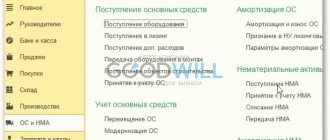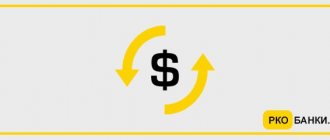The 1C: Accounting program has a wide range of options for recording transactions, including crediting funds to a bank account or debiting from it. To carry out such operations, you must first enter your account details. This is done through the “Bank Accounts” tab in the organization information form.
It is also required to enter data on the accounts of counterparties from which transfers will be made. It is possible to enter information about them both in bank documents and when filling out the “Counterparties” directory.
In most cases today, settlements between the parties are carried out on the Internet through the “Bank-Client”, and fully prepared bank statements are sent to the 1C program. Accordingly, the user is only required to prepare payment orders. At the same time, if necessary, you can create bank documents manually.
Filling out your own organization's payment details
First of all, you need to fill out the payment details of our organization. To do this, go to the “Main Menu-Organizations” menu.
Fig.1 Filling out payment details of your own organization
In the list of organizations, select the one for which you need to set bank details, and go to the “Bank Accounts” tab.
Fig.2 Go to the “Bank Accounts” tab
If the organization has several current accounts, fill in the data for each of them, and also select the main one, which can only be one.
Fig.3 Select the main account
After entering all the data, you must click “Save and close”.
simplified tax system
If an organization applies a simplification, then the reflection of money written off from the current account depends on its purpose. This is due to the fact that expenses under this regime are recognized at the time of their actual payment (clause 2 of Article 346.17 of the Tax Code of the Russian Federation).
So, if an organization transfers money for purchased goods to a supplier, then take such expenses into account when calculating the single tax at the time of payment (subclause 1, clause 2, article 346.17 of the Tax Code of the Russian Federation).
For more information on how to reflect the debiting of funds for various purposes from a current account when calculating a single tax, see What expenses should be taken into account when calculating a single tax on the simplified tax system.
Situation: how to reflect the funds that are in the organization’s current account when calculating the single tax? The bank servicing the organization has had its license revoked.
After the license is revoked, the Bank of Russia begins bank bankruptcy proceedings if the credit institution shows signs of insolvency specified in Article 2 of Law No. 40-FZ of February 25, 1999. If these signs are not present, the Bank of Russia applies to the arbitration court with a demand to liquidate the credit institution forcibly. This procedure is provided for in Article 23.1 of the Law of December 2, 1990 No. 395-1.
During the bankruptcy procedure, the bank can repay its debt to the organization (Clause 1 of Article 408 of the Civil Code of the Russian Federation, Articles 50.30, 50.35 of the Law of February 25, 1999 No. 40-FZ). Do not take into account the amounts received in income when calculating the single tax (subclause 1, clause 1.1, article 346.15, articles 41 and 248 of the Tax Code of the Russian Federation).
If the bank has not paid the organization the funds in its current account, then such an amount of bad debt cannot be taken into account in the organization’s expenses using the simplified procedure. This is explained by the fact that this type of expense is not included in the closed list provided for in Article 346.16 of the Tax Code of the Russian Federation.
Filling out payment details of counterparties
Access to the payment details of counterparties is carried out through the menu “Main Menu-Directories-Counterparties”.
Fig.4 Access to payment details of counterparties
In the list that opens, select the counterparty for whom you need to fill out payment details, or enter a new one. These payment details are filled in by analogy with the details of your own company.
Fig.5 Select the counterparty for whom you need to fill out payment details, or enter a new one
Bank statement
In the 1C 8.3 program, the document reflecting the movement of funds across accounts is a bank statement. It simultaneously reflects income and expenses, and also shows balances at the beginning and end of the day. After entering all payment orders into the program, as well as debit documents, you need to generate a bank statement to check receipts and expenses for the day, as well as control the balance of funds at the end of the day.
Fig.6 Bank statement
In the bank statement, we can select the period for which we want to take transactions, select a specific organization, or a current account for a more detailed consideration.
What is a current account and why does a business need it?
A current account is understood as a special account in a financial institution, with the help of which a legal entity or individual entrepreneur can carry out certain monetary transactions. In the company details, the current account is a combination of 20 numbers that carry certain information.
With a current account you can:
- pay for services and goods non-cash;
- accept payment for your services from other individual entrepreneurs and legal entities;
- store money, keep records of it;
- collect funds;
- pay wages;
- accept payments by bank cards or via online acquiring;
- carry out currency transfers and much more.
Current account holders can also gain access to other banking services - overdraft, interest on the minimum balance, factoring. Without a current account it is impossible to participate in tenders. With its help, it is easier to make payments under compulsory medical insurance, to the Pension Fund and other government agencies
Admission
In the course of its business activities, the enterprise receives funds from customers into its bank account and accepts them for accounting.
To see receipts to the company’s current accounts, the 1C system provides the document “Receipts to Account”.
Fig.7 Receipts to the account
When you select this menu, a complete list of documents “Receipt to account” opens. From this interface, existing documents are visible, new documents for receipt of funds are created manually, and statements from the client bank are also downloaded, while the 1C system will automatically create the necessary documents.
Fig.8 Complete list of documents “Receipt to account”
When generating receipts manually, in the first step we indicate the type of operation to be performed. The set of fields in the document and the formation of accounting entries depend on this.
Fig.9 When generating receipts “by hand”, in the first step we indicate the type of operation to be performed
After selecting the type, a window for a new receipt document will open.
In the header of the document we indicate:
- The name of the company to which the receipt of funds will be reflected. If the program keeps records for several organizations, select the one you need. Current account and bank information will be filled in automatically;
- Organization account;
- Buyer;
- Amount of payment;
- Incoming number and date of the bank payment document.
Fig. 10 Filling out the header
Information for financial accounting in the company is entered into the tabular part of the document:
- Contract number;
- DDS article;
- Buyer's order (if orders are kept track of);
- Amount of payment;
- VAT amount.
Fig. 11 Filling out the tabular part of the document
After filling out all the data, the document can either be recorded or posted.
Acceptance of payment requests
The legislation provides for two types of settlements for collection of payment claims:
- with acceptance;
- without acceptance.
This is stated in paragraph 2.1 of the Bank of Russia Regulations dated June 19, 2012 No. 383-P.
The acceptance condition of the organization and its counterparty is prescribed in the supply agreement (performance of work, provision of services, etc.), as well as in the banking service agreement (clause 2 of article 862 of the Civil Code of the Russian Federation, clause 2.9 of the Bank of Russia Regulations of June 19, 2012 No. 383-P).
The executing bank transfers the payment request to the payer with acceptance no later than the next business day from the date of its receipt by the bank (paragraph 5, clause 2.13 of Bank of Russia Regulations of June 19, 2012 No. 383-P).
Upon receipt of a payment request, the payer can:
- accept it in full;
- accept partially;
- refuse acceptance.
To do this, within the period established for acceptance, submit to the bank an application for acceptance or refusal of acceptance in the form established by the bank.
The bank pays the accepted payment request from the payer’s account no later than the business day following the day of receipt of the application, unless another period is provided for by the agreement (Article 849 of the Civil Code of the Russian Federation).
In case of partial acceptance, the bank sends to the sender of the request a copy of the application for acceptance (refusal of acceptance) indicating the date, stamped by the bank and signed by an authorized person of the bank no later than the business day following the day of receipt of partial acceptance.
In case of complete refusal of acceptance, the executing bank returns the payment request to the recipient's bank along with a statement of refusal to accept. The executing bank must do this no later than the next day after receiving the application or the day no later than which the payer’s acceptance must be received.
This procedure is provided for in clause 2.9.2 of the Bank of Russia Regulations dated June 19, 2012 No. 383-P.
Creating “Account Receipts” based on an invoice for payment
The 1C system provides the ability to create receipt documents based on a previously issued invoice to the buyer. To do this, go to the “Sales-Invoices” menu.
Fig. 12 Creation of “Account Receipts”
In the list of accounts, find, select and open an account for which you need to create a payment document and click “Enter based on - Receipt to account”.
Fig. 13 Enter based on - Receipt to account
In this case, all the details filled in in the invoice will be automatically added to the receipt. If necessary, they can be adjusted manually. After filling out all the fields, the document can be recorded or posted.
Setting up the program
Before you begin to reflect the movement of funds on your current account, it must be indicated in the program.
Open your organization’s card in the directory of the same name and follow the “Bank Accounts” hyperlink. You will see a list of all previously entered accounts. There may be several of them, but only one will be the main one.
When creating a new bank account, you will need to indicate its number, account currency and the bank in which it is opened. You can also specify other data if desired.
Our team provides consulting, configuration and implementation services for 1C. You can contact us by phone +7 499 350 29 00 . Services and prices can be seen at the link. We will be happy to help you!
Money orders
To prepare payment documents and send them to the bank, the 1C system provides the “Payment Order” document.
Fig.14 Payment order
When you select this menu, a complete list of “Payment orders” documents opens. From this interface you can view existing payments, create new ones manually, and send the prepared ones to the client bank.
Fig. 15 Complete list of documents “Payment orders”
To create a payment order, you must click “Create” and select the type of operation – “Payment to counterparty” or “Transfer to the budget”.
Fig. 16 Select the type of operation - “Payment to the counterparty” or “Transfer to the budget”
After selecting the type of operation, a new document will open in which you need to fill in the details of the payer, recipient, amount, VAT, purpose of payment.
Fig.17 New document
To save the entered data in the payment order, you need to click the “Save” button, or “Save and close”.
Ready payments are uploaded to the client bank. To do this, select in the list of documents those that need to be sent and click the “Upload from 1C to bank” button.
Fig. 18 Ready payments are uploaded to the client bank
Types of settlement documents
For non-cash payments, the following types of documents are used:
- payment order;
- letter of credit;
- check;
- payment request;
- collection order;
- payment order.
These types of settlement documents are provided for in Article 862 of the Civil Code of the Russian Federation and clause 1.1 of Bank of Russia Regulation No. 383-P dated June 19, 2012.
In addition, funds can be debited from the organization’s current account when making payments with a plastic card. For more information on how to spend money using a bank card, see How you can issue money on account.
The organization and its counterparty (supplier, performer) have the right to choose the form of payment independently and provide for it in the contract (clause 2 of Article 862 of the Civil Code of the Russian Federation, clause 1.1 of the Bank of Russia Regulations of June 19, 2012 No. 383-P).
Debiting funds from a current account
To reflect expense transactions on a current account, the 1C system provides the “Account Expense” document.
Fig. 19 Document “Account Expense”
When you select this menu, a complete list of “Account Expense” documents opens. From this interface you can view existing documents, create a new debit document manually, or download statements from the client bank, and the 1C system will automatically create the necessary documents.
Fig. 20 Complete list of documents “Account Expenses”
To create a new document “Account Expense”, you must click the “Create” button and select “Operation Type”. The composition of the fields in the document and the formation of accounting entries depends on this.
Fig.21 Select “Type of operation”
In the new document we enter the details of the payer, recipient, amount, VAT, date and number of the bank document, as well as the tabular part, which contains detailed information on payment for financial accounting.
Fig.22 Filling out a new document
The prepared document can be recorded or posted.
Accounting
Write off funds from the organization's current account in accounting by posting entries to the credit of account 51 “Current accounts”.
When writing off money to pay for obligations under an agreement with counterparties, make the following entries in your accounting:
Debit 60 (76, 62, 66, 67, 91-2...) Credit 51
– money is debited from the current account to pay obligations under the contract.
For information about what transactions need to be made if an employee of an organization pays contractors with a bank card, see How can you issue money on account?
Reflect the transfer of taxes to the budget by posting:
Debit 68 Credit 51
– funds were transferred to pay taxes.
When paying contributions for compulsory pension (medical, social) insurance, make the following entries in your accounting:
Debit 69 subaccount “Settlements with the Social Insurance Fund for social insurance contributions” Credit 51
– contributions to the Social Insurance Fund of Russia are transferred;
Debit 69 subaccount “Settlements with the Pension Fund” Credit 51
– pension contributions are transferred;
Debit 69 subaccount “Settlements with FFOMS” Credit 51
– contributions for health insurance to the Federal Compulsory Medical Insurance Fund are transferred;
Debit 69 subaccount “Settlements with the Social Insurance Fund for contributions to insurance against accidents and occupational diseases” Credit 51
– contributions for insurance against accidents and occupational diseases are listed.
Record the write-off of funds for payments to employees (salaries, etc.) by posting:
Debit 70 (73, 71) Credit 51
– the debt to the organization’s employees has been repaid.
Reflect payments to founders in accounting by writing:
Debit 75-1 Credit 51
– dividends are transferred to the founders (if they are not employees of the organization).
This procedure is established in the Instructions for the chart of accounts.
Situation: how to reflect in accounting the funds that are in the organization’s current account? The bank servicing the organization has had its license revoked.
From the day the bank’s license is revoked, account for funds in account 55 “Special accounts in banks.” In accounting, reflect this by posting:
Debit 55 Credit 51
– the balance of funds in the bank account from which the license has been revoked is reflected.
After you submit an application to close the account and return the money, reflect the accounts receivable in your accounting in the amount of the balance of funds in the account:
Debit 76 Credit 55
– the bank’s receivables are reflected for the amount of funds in the account (as of the date of filing the application);
Debit 91-2 Credit 63
– a reserve for doubtful debts of the bank has been created.
This procedure was recommended by the Russian Ministry of Finance in letter dated February 6, 2015 No. 07-04-06/5027.
Information about the revocation of licenses from banks can be found in the printed publication “Bulletin of the Bank of Russia” and the periodical printed publication at the location of the bank (clause 3 of Article 189.26 of the Law of October 26, 2002 No. 127-FZ).
You can write off the debt you have incurred from account 76 if one of the following cases occurs:
- the bank repaid the debt (for example, during bankruptcy proceedings) (clause 1 of Article 408 of the Civil Code of the Russian Federation);
- the bank was liquidated (Article 419 of the Civil Code of the Russian Federation).
If the bank has paid off its obligations to the organization, then reflect the amount received on account of the debt with the following entries:
Debit 51 Credit 76
– funds returned during the liquidation of the bank have been received;
Debit 63 Credit 91-1
– the reserve for the bank’s receivables has been restored.
If the bank is liquidated, its debt can be written off as uncollectible:
Debit 63 Credit 76
– the bank’s bad receivables are written off at the expense of the created reserve.
In this case, the bank is considered liquidated after the corresponding entry is made in the Unified State Register of Legal Entities (clause 9 of Article 63 of the Civil Code of the Russian Federation). An organization can find out about the exclusion of a bank from the Unified State Register of Legal Entities by submitting, for example, a request to the tax office (clause 20 of the Administrative Regulations, approved by Order of the Ministry of Finance of Russia dated January 15, 2015 No. 5n).
Situation: how to reflect the transfer of funds to a counterparty in accounting? The bank servicing the counterparty has had its license revoked.
In accounting, reflect the transfer of funds to the counterparty in the general manner.
Reflect the write-off of funds from the organization's current account in accounting by entries on the credit of account 51 “Current accounts”:
Debit 60 (76, 62, 66, 67, 91-2...) Credit 51
– money is debited from the current account to pay obligations under the contract.
But the counterparty will need to account for these funds in account 55 “Special accounts in banks.”
This procedure is established in the Instructions for the chart of accounts (account 51).
Situation: can an individual entrepreneur withdraw cash from a current account without restrictions for personal needs?
Yes maybe.
All income an individual entrepreneur receives from his activities is his personal funds, including cash. He can dispose of them at his own discretion, since an individual entrepreneur is not a legal entity and his property is not legally delimited (clause 1 of article 23, clause 24, clause 1 of article 861 of the Civil Code of the Russian Federation).
At the same time, the entrepreneur is obliged to comply with the procedure for conducting cash transactions and storing cash (clause 4 of article 346.11, clause 5 of article 346.26 of the Tax Code of the Russian Federation, clause 18 of the Regulations approved by Decree of the Government of the Russian Federation of May 6, 2008 No. 359, p 1 instructions of the Bank of Russia dated March 11, 2014 No. 3210-U). Amounts of cash in excess of the established limit, if the entrepreneur has established it, must be kept in a current account (clause 2 of the Bank of Russia Directive No. 3210-U dated March 11, 2014).
If necessary, an entrepreneur can withdraw funds from the current account for any needs without restrictions. There is no need to prepare an advance report on the amounts spent on personal needs. Similar explanations are given in the letter of the Bank of Russia dated August 2, 2012 No. 29-1-2/5603.
The procedure for calculating taxes depends on the tax system that the organization uses.
BASIC
If an organization uses the accrual method, then writing off money from the current account will not affect the calculation of income tax. This is due to the fact that the recognition of expenses in this case does not depend on the debiting of money from the organization’s current account (clause 1 of Article 272 of the Tax Code of the Russian Federation).
An example of how to reflect in accounting and taxation the debiting of money from a current account when making payments using collection orders. The organization uses the accrual method
On July 1, Torgovaya LLC entered into a long-term agreement with Alfa CJSC. Under the agreement, Alpha provides telephone services to Hermes. Hermes pays for the provided communication services on a monthly basis. The agreement provides for a collection form of payments (collection orders).
The agreement between Hermes and the bank servicing it contains a provision regarding the bank’s right to write off funds from the client’s account without his order.
In July, Alpha provided RUB 59,000. (including VAT – 9000 rubles). On August 1, Alpha’s accountant issued a collection order for this amount and submitted it to the bank servicing the organization.
On August 1, “Hermes” submitted information to the bank servicing it: – about the recipient of funds (“Alfa”), who has the right to issue collection orders to write off funds in an indisputable manner (full name, legal and actual address, telephone number, INN, KPP, OGRN, bank details, information about the manager and chief accountant); – on the agreement with Alfa for the provision of communication services.
The bank debited the money from the Hermes account on August 2.
The accountant of Hermes reflected the transactions performed in the accounting as follows.
July 30:
Debit 26 Credit 60 – 50,000 rub. – reflects the cost of communication services for July;
Debit 19 Credit 60 – 9000 rub. – input VAT is taken into account;
Debit 68 subaccount “Calculations for VAT” Credit 19 – 9000 rub. – accepted for VAT deduction (based on the supplier’s invoice).
August 2:
Debit 60 Credit 51 – 59,000 rub. – money was debited from the current account to pay for the services of the communication provider (based on a bank statement).
Hermes uses the accrual method, so debiting funds from the current account to pay for services to a supplier will not in any way affect the calculation of income tax.
If an organization calculates income tax using the cash method, then the reflection of money written off by the bank from the current account depends on its purpose. This is due to the fact that expenses under the cash method are recognized at the time of their actual payment (clause 3 of Article 273 of the Tax Code of the Russian Federation). For example, if an organization transfers money for the services of third-party contractors, then such expenses must be taken into account when calculating income tax at the time of debiting funds from the current account (clause 3 of Article 273 of the Tax Code of the Russian Federation).
Situation: how to reflect the funds that are in the organization’s current account when calculating income tax? The bank servicing the organization has had its license revoked.
Funds in a current account in a bank that has lost its license can be taken into account when taxing profits only after the liquidation of such a bank.
After the license is revoked, the Bank of Russia begins bank bankruptcy proceedings if the credit institution shows signs of insolvency specified in Article 2 of Law No. 40-FZ of February 25, 1999. If these signs are not present, the Bank of Russia applies to the arbitration court with a demand to liquidate the credit institution forcibly. This procedure is provided for in Article 23.1 of the Law of December 2, 1990 No. 395-1.
In this case, the organization must declare its claims to the bank and be included in the register of creditors’ claims (Articles 50.28, 50.30 of the Law of February 25, 1999 No. 40-FZ).
During the bankruptcy procedure, the bank can repay its debt to the organization (Clause 1 of Article 408 of the Civil Code of the Russian Federation, Articles 50.30, 50.35 of the Law of February 25, 1999 No. 40-FZ). Do not reflect the amounts received, regardless of the method for determining income tax, in income (Articles 41 and 248 of the Tax Code of the Russian Federation).
If the bank has not paid the amount of debt in the form of funds listed on the organization’s current account, then it has the right to classify the specified amount as bad debts and write it off (clause 2 of Article 266 of the Tax Code of the Russian Federation). This can be done when the bank is liquidated (as a result of bankruptcy or forced liquidation) and an entry about this will be made in the Unified State Register of Legal Entities (Article 419, paragraph 9 of Article 63 of the Civil Code of the Russian Federation, letters of the Ministry of Finance of Russia dated March 4, 2013 No. 03 -03-06/1/6313, dated October 19, 2012 No. 03-03-06/1/559). This rule applies to both the accrual method and the cash method.
An organization can find out about the exclusion of a bank from the Unified State Register of Legal Entities by submitting a corresponding request to the tax office (clauses 20, 22 of the Administrative Regulations, approved by Order of the Ministry of Finance of Russia dated January 15, 2015 No. 5n).
Expense from account based on payment order
The “Account Expense” document can be created based on a previously created payment slip. Open it, click the “Create based on-Account Expense” button. In this case, all the details filled out in the payment order will be automatically inserted into the new document. They can also be adjusted manually. Otherwise, the execution of the “Account Expense” document is carried out in the same way as described above.
Fig. 23 Expense from an account based on a payment order
How to unblock a current account
Unblocking an account is a procedure that will take some time. To begin with, the taxpayer is obliged to correct the violations - submit the required reports and pay taxes and penalties. The amount of penalties can be calculated using our penalty calculator. After this, you must provide the inspector with evidence that all obligations have been fulfilled.
Important: To avoid double transfer of arrears, the taxpayer should ensure that an amount sufficient to repay the debt under the collection order is received into the account, and not pay them themselves.
The decision to cancel the blocking of the account is made within 1-2 days and sent to the bank servicing the taxpayer.
A manager or individual entrepreneur, as well as a person acting under their power of attorney, can obtain a decision from the tax office to cancel the account blocking and submit it to the bank in person. This reduces the processing time for the document significantly.
Until 2014, if an account was frozen, it was possible to quickly conclude a service agreement with another bank and open another account. Now clause 12 of Art. is in force. 76 NR FR, according to which banks do not have the right to open accounts or issue corporate debit cards to taxpayers who have a blocked account.
Posting control
To control the correct formation of transactions, you can view the “Document Movements” and adjust the movement of the document according to the accounting accounts.
Fig.24 Wiring control
Fig.25 Wiring control
In this article, we looked at the mechanisms for reflecting receipts and write-offs, and got acquainted with the possibilities of fast and error-free operation that the 1C 8.3 program offers to its users.






